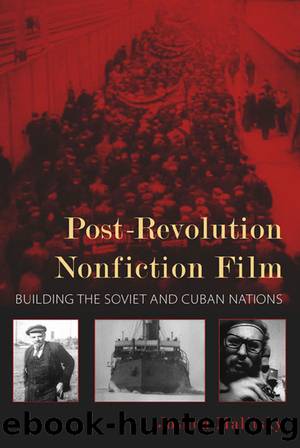Post-Revolution Nonfiction Film by Malitsky Joshua;

Author:Malitsky, Joshua;
Language: eng
Format: epub
Publisher: Indiana University Press
Such determination and moral and political commitment are shown to be the legacy Ho leaves to his people, who mourn his death with great emotion in the subsequent section. Foreign diplomats as well as Vietnamese children, adults, and seniors are visibly overwhelmed by the loss. As a funeral speech is read (not subtitled into Spanish), accompanied by the non-diegetic drumbeats and electric keyboard of Iron Butterfly (which shortly thereafter take over for the speech), an array of people walk past to pay their respects. Each group is presented in slow motion. In one example, peopleâs movements superimpose and eventually dissolve into that of another groupâs. In another, ambulating feet gradually dissolve into a negative image, recalling the sequence in which Ho Chi Minh is seen aging. In one other, Ãlvarez and his special effects coordinator Pepin Rodriguez construct a shot in which it appears that people walk with their own ghosts slightly behind them. The effect is achieved by the superimposition of two shots. The first is an image of visibly distraught students descending a staircase in slow motion. The second consists of the same shot as the first, only captured after a one- to two-second lag time. When these images are superimposed, the students appear to be walking along with their own transparent traces. It is a remarkable effect that, along with the other aesthetic choices in the sequence, articulates a sense of collective unity and historicity. The superimpositions reinforce the idea of a populace united behind a leader. The negative images and trace effect capture a shared historyâshared between Ho and his people and shared among the people. In this case, it is not just the photographic nature of the image but what distinguishes cinema from photographyâits existence in timeâthat is critical. Ãlvarezâs effects in this sequence rely on motion to construct a sense not of embalmed history but of historical progress. It is movement in time and through time. The point, and this is reiterated at the end of the film, is that the funeral is not the culmination of a struggle. The film is not a wholly historical document of Hoâs life. It is a statement and an attempt to realize historical movement. The people, both Vietnamese and Cuban, are in the midst of a battle that must continue until âan everlasting Springââthe realization of both Hoâs and Cheâs visionsâis finally reached.
The section concludes with another intertitle, this one from José MartÃ. He writes, DEATH ISNâT REAL WHEN A LIFEâS WORK HAS BEEN WELL FULFILLED. The quote reinforces this sectionâs connections with the first section of the film about Hoâs life and contrasts it with those that focus on the war. Both the funeral and the biographical sections urge citizens to think about what is involved in living a meaningful life (and therefore leaving a lasting legacy). They are emotionally and intellectually reflective as opposed to viscerally jarring. They are about steeling the heart for action and preparing to engage a battle without fear, no matter the consequences.
Download
This site does not store any files on its server. We only index and link to content provided by other sites. Please contact the content providers to delete copyright contents if any and email us, we'll remove relevant links or contents immediately.
| Coloring Books for Grown-Ups | Humor |
| Movies | Performing Arts |
| Pop Culture | Puzzles & Games |
| Radio | Sheet Music & Scores |
| Television | Trivia & Fun Facts |
The Kite Runner by Khaled Hosseini(5038)
Gerald's Game by Stephen King(4515)
Dialogue by Robert McKee(4272)
The Perils of Being Moderately Famous by Soha Ali Khan(4122)
The 101 Dalmatians by Dodie Smith(3423)
Story: Substance, Structure, Style and the Principles of Screenwriting by Robert McKee(3366)
The Pixar Touch by David A. Price(3331)
Confessions of a Video Vixen by Karrine Steffans(3206)
How Music Works by David Byrne(3079)
Harry Potter 4 - Harry Potter and The Goblet of Fire by J.K.Rowling(2942)
Fantastic Beasts: The Crimes of Grindelwald by J. K. Rowling(2907)
Slugfest by Reed Tucker(2898)
The Mental Game of Writing: How to Overcome Obstacles, Stay Creative and Productive, and Free Your Mind for Success by James Scott Bell(2819)
4 - Harry Potter and the Goblet of Fire by J.K. Rowling(2612)
Screenplay: The Foundations of Screenwriting by Syd Field(2505)
The Complete H. P. Lovecraft Reader by H.P. Lovecraft(2459)
Scandals of Classic Hollywood: Sex, Deviance, and Drama from the Golden Age of American Cinema by Anne Helen Petersen(2437)
Wildflower by Drew Barrymore(2418)
Casting Might-Have-Beens: A Film by Film Directory of Actors Considered for Roles Given to Others by Mell Eila(2326)
